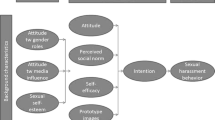Abstract
This study describes an evaluation of a school-based sexual abuse awareness and prevention program that featured the “Red Flag/Green Flag People” coloring book and included presentation of a film (“Better Safe than Sorry II”) and discussion of hypothetical and actual experiences involving inappropriate physical touching. Children, parents, and teachers from two experimental schools participated in the program and were compared to similar groups from a control school. Outcomes were evaluated using pre-post (2-month) assessment questionnaires. Among the findings obtained, experimental group children reported learning more about the differences between good and bad touching, and being more likely to both report instances of sexual victimization and utilize program-specific preventive skills, relative to controls. Parents exposed to program materials acknowledged greater improvements in knowledge about program goals and more positive communication at home about abuse. Although no significant differences were obtained for teachers, the ratings for one experimental group were consistently higher than those of the other groups. Staff volunteers evaluated the program as overwhelmingly positive and without adverse effects. Still, some children from all groups reported being touched inappropriately. Some of these improvements were also noted for the experimental group at 6-month follow-up assessment. The findings were discussed in the context of conceptual, clinical, training, and empirical considerations.
Similar content being viewed by others
References
Better Safe Than Sorry II. (1979). Film Fair Communications, 900 Ventura Blvd., Box 1728, Studio, Calif. 91604.
Conte, J. R., Rosen, C., Saperstein, L., and Shermack, R. (1985). An evaluation of a program to prevent the sexual victimization of young children.Child Abuse Neg. 9: 319–328.
Downer, A. (1984).The Development and Testing of an Evaluation Instrument for Assessing the Effectiveness of a Child Sexual Abuse Prevention Curriculum: Talking about Touching, Committee for Children, Seattle, Wash.
Hazard, A. (1984). Training teachers to identify and intervene with abused children.J. Clin. Child Psychol. 13: 288–293.
Helfer, R. E. (1982). A review of the literature on child abuse and neglect.Child Abuse Negl. 6: 251–261.
Kempe, R. S., and Kempe, C. H. (1984).The Common Secret: Sexual Abuse of Children and Adolescents, Freeman, New York.
Kinard, E. M. (1985). Ethical issues in research with abused children.Child Abuse Negl. 9: 301–312.
Kulka, C. M. (1984).A Survey Study of Attitudes and Opinions Regarding a Third Grade Sexual and Physical Abuse Prevention Program, Unpublished Master's Thesis, North Dakota State University, Fargo, N.D.
Nurcombe, B. (1986). The child as witness: Competency and credibility.J. Amer. Acad. Child Psychiat. 25: 473–48.
Plummer, C. (1984).Preventing Sexual Abuse: What In-School Programs Teach Children, Paper presented at the Second National Conference for Family Violence Researchers, Durham, N.H.
Ray, J., and Dietzel, M. (1984).Teaching Child Sexual Abuse Prevention, Unpublished Manuscript, Spokane, Wash.
Rosenberg, M. S., and Reppucci, N. D. (1985). Primary prevention of child abuse.J. Consult. Clin. Psychol. 53: 576–585.
Volpe, R. (1984). A psychoeducational program dealing with child abuse for elementary school children.Child Abuse Negl. 8: 511–517.
Williams, G. J. R. (1983). Child abuse reconsidered: The urgency of authentic prevention.J. Clin. Child Psychol. 12: 312–319.
Williams, J. (1980).Red Flag/Green Flag People, Rape and Abuse Crisis Center, Fargo, N.D.
Wolfe, D. A., MacPherson, T., Blount, R., and Wolfe, V. V. (1986). Evaluation of a brief intervention for educating school children in awareness of physical and sexual abuse.Child Abuse Negl. 10: 85–92.
Author information
Authors and Affiliations
Rights and permissions
About this article
Cite this article
Kolko, D.J., Moser, J.T., Litz, J. et al. Promoting awareness and prevention of child sexual victimization using the Red Flag/Green Flag program: An evaluation with follow-up. J Fam Viol 2, 11–35 (1987). https://doi.org/10.1007/BF00976368
Issue Date:
DOI: https://doi.org/10.1007/BF00976368




